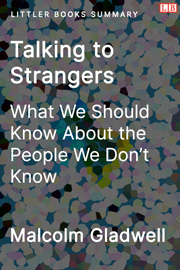Book Description
A thought-provoking exploration of how we perceive and interact with those we don't know.
If You Just Remember One Thing
Approach strangers with humility, not certainty. Ask more questions and challenge your assum... More
Bullet Point Summary and Quotes
- During their encounter in Munich in 1938, British Prime Minister Neville Chamberlain believed that Adolf Hitler was a trustworthy person. This is an example of how we are generally bad at judging people.
- A 2017 research conducted by Harvard economist Sendhil Mullainathan showed that bail judges, who are confident in their ability to evaluate people, were less accurate in assessing defendants than a computer program that only used age and criminal record as criteria, indicating that we are overconfident in our ability to make character judgments based on limited information.
- Psychologist Emily Pronin conducted an experiment in 2001 where participants chose missing letters in words and then dismissed their word choices as meaningless, but when shown lists of word choices made by strangers, participants confidently assigned personality traits to those strangers. This indicates that people tend to judge strangers based on limited information, but in reality, strangers are complex and difficult to accurately evaluate.
- Ana Montes was one of the most infamous spies in US history. There were many red flags that were ignored by the US Defense Intelligence Agency because it's common human tendency to believe people are telling the truth unless there is overwhelming evidence to the contrary.
- In an experiment by psychologist Tim Levine, professionals such as therapists, police officers, judges, and CIA officers were asked to identify who is lying about cheating on a trivia test. People only correctly identified the cheaters 54% of the time, because they generally believed that most people are telling the truth and required an obvious trigger to tip from suspicion to disbelief.
- Bernie Madoff, who defrauded thousands of investors of over $60 billion, could have been prevented if people were better at spotting fraud and deception. Harry Markopolos, an independent fraud investigator, was able to see through Madoff's deception because he didn't assume that everyone tells the truth.
- However, lies are relatively uncommon in real life, and most interactions are fundamentally honest. Defaulting to the truth is more practical for most people. Madoff and other fraudsters are outliers.
- Transparency is the idea that a person's demeanor reflects their true feelings, but it can be misleading.
- A study in which participants' environment was suddenly modified to something completely strange resulted in only five percent of them showing the look of surprise on their faces.
- When we try to read a stranger's face, we can misinterpret what they are thinking, which can have serious consequences.
- Amanda Knox was initially the main suspect in the murder of Meredith Kercher, despite there being no physical evidence linking her to the crime. This was due to the police misinterpreting her behavior as guilty and transparent. Knox's behavior didn't match what was expected of someone in a grieving situation, leading to suspicion. However, the problem is that not everyone is transparent, and their demeanor may be mismatched to what they are actually thinking or feeling.
- Many liars can look at you directly and lie confidently. Many honest people can look nervous and suspicious.
- Alcohol disables us from making judgements that have long-term consequences. The author believes alcohol was an important part of Brock Turner's sexual assault on an unconscious woman.
- In 2015, Sandra Bland, an African-American woman, was pulled over for failing to signal a lane change. The situation escalated quickly, and she was eventually violently arrested and found dead in police custody three days later. The situation demonstrates the danger of defaulting to the truth in inappropriate situations, as well as the flaws of assuming one can interpret character from demeanor. Encinia, the police officer involved, assumed Bland was a threat when she seemed agitated and lit a cigarette, instead of seeing it as a sign of stress.
- We need to be more aware of the limitations of our own understanding when we're dealing with strangers, ask more questions, be more skeptical of people's motives, and be willing to challenge our own assumptions.
Talking to Strangers: Resources
- Download this summary and 173+ other top nonfiction book summaries in one book (PDF, eBook, DOCX)
- Buy the book
